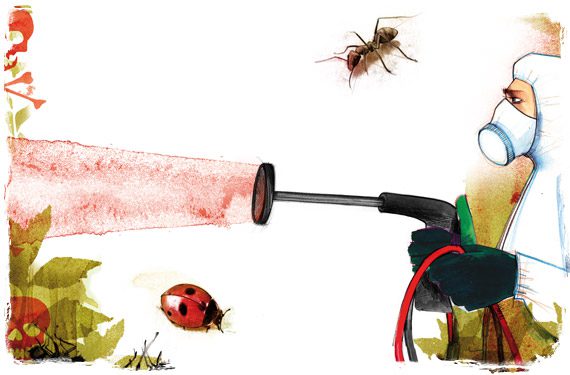South Africa is a great location for cultivating plants, but one of the prevalent challenges has to do with pests and this can be a real problem. There have been provision of different solution to combat pest challenges especially the use of pesticides.
However, we will be looking at the use of Natural predators for pest control which is one of the newest methods of combating pests in plant cultivation.
Use of Natural predators can be a great solution to protect your crop, and it is deemed a safe and effective way to reduce pest infestations and keep your plants healthy without the use of chemicals.
It is for this reason that we will discuss in this article the advantages and disadvantages of using natural predators for pest control, the different types of predators available, and the best practices for implementing natural predator control in South Africa.
How To Use Natural Predators For Pest Control Plant Cultivation In South Africa
Pest control in South Africa is an important aspect of plant cultivation. Unfortunately, due to the warm climate, South Africa is plagued with a wide variety of pests that can destroy crops, gardens, and landscapes.
Some of these pests include aphids, whiteflies, mealybugs, thrips, and spider mites. Fortunately, there are a variety of natural predators that can be used to keep these pests in check.
Different Types of Natural Predators Available and How to use Them
There are varieties of natural predators that you can introduce to your farm. Below are the common ones that can be used in South Africa.
Ladybug
One of the most common natural predators used for pest control in South Africa is the ladybug. Ladybugs feed on aphids and other soft-bodied insects, and they can easily be introduced into your garden by simply releasing them into the garden. The ladybug is an ideal natural predator to use because it is harmless to other beneficial insects, such as honeybees and butterflies.
How to use Ladybug as a Natural Predator for Pest Control
Ladybugs can be used in several ways to help protect plants from damage caused by pests.
- Purchase ladybugs from a garden center or online supplier and release them into your garden or farm. Ladybugs will naturally seek out areas where they can find food, so releasing them near your crops is a good idea.
- Introduce natural predators into your garden or farm. Ladybugs feed on aphids and other soft-bodied pests, but other beneficial insects, such as lacewings, ground beetles, and parasitic wasps, can also help to keep pest populations under control.
- Plant companion flowers near your crops. Ladybugs are attracted to certain types of flowers, so planting them near your crops can help to draw them in.
- Keep your garden or farm free of weeds and debris. Ladybugs need somewhere to hide during the day, so keeping your garden or farm free of weeds and debris will help to provide them with the shelter they need.
- Provide water and food sources. Ladybugs do not need large sources of water, but providing them with shallow dishes of water and small piles of ripe fruit or vegetables can help to attract them to your garden or farm.
- Introduce ladybugs into greenhouses. Ladybugs can help to control pest populations in greenhouses, which can be difficult to manage using traditional methods.
Lacewing
Another natural predator used for pest control in South Africa is the lacewing. Lacewings, which have long, delicate wings, feed on aphids, mites, and other small insects. These beneficial insects can be purchased from garden centers or can be released directly into the garden.
How to use Lacewing as a Natural Predator for Pest Control
- Identify and monitor pest populations in your garden or field. This will help you determine the extent of the pest problem, as well as the type of pest that is causing the damage.
- Purchase lacewing eggs and larvae from a reputable supplier. This will ensure that you are getting a quality product that has been raised under optimal conditions.
- Release lacewing larvae into the affected area of the garden or field. This can be done by sprinkling the larvae on the plants or placing them in containers near the affected area.
- Monitor your plants for signs of lacewing activity. This will help you determine the effectiveness of the lacewing as a natural predator for pest control.
- Re-apply lacewing larvae as needed. This will help ensure that the lacewing population remains strong and effective in controlling the pest population.
- Use other methods of pest control, such as physical removal and the use of natural insecticides, in conjunction with lacewing larvae. This will help to ensure that the pest infestation is completely eradicated.
The Praying Mantis
The praying mantis is another natural predator that is commonly used for pest control in South Africa. Praying mantises feed on a variety of insects, including aphids, mites, and caterpillars. Praying mantises can be purchased from garden centers or can be released directly into the garden.
How to use the Praying Mantis as a Natural Predator for Pest Control
- Identify potential pest problems in your garden. Praying mantises are known to feed on a variety of insects, including aphids, caterpillars, crickets, and grasshoppers.
- Collect or buy praying mantis egg cases. Praying mantises are easy to find in the wild, but the easiest way to obtain them is to purchase egg cases online.
- Introduce the egg cases to your garden. Egg cases can be placed in your garden in areas where pests are most likely to be found.
- Monitor your garden for pests. Praying mantises are most active at night, so check your garden frequently for signs of pests.
- Remove any dead or dying praying mantises. Praying mantises can be killed by predators or by environmental factors such as extreme temperatures or drought.
- Provide shelter for praying mantises. Praying mantises need shelter from the elements and from predators. Place sticks, leaves, or other natural materials in your garden to provide shelter for the mantises.
- Monitor your garden for signs of success. Praying mantises can help control pest populations in your garden. If you notice fewer pests, then the praying mantis
Butterfly
Another natural predator used for pest control in South Africa is the butterfly. Butterflies feed on a variety of insects, including aphids, moths, and caterpillars. Butterflies can be purchased from garden centers or can be released directly into the garden.
How to use Butterfly as a Natural Predator for Pest Control
#1. Choose The Right Butterflies
Knowing which butterflies are natural predators for pest control plant cultivation in South Africa is important. In South Africa, the Monarch butterfly is a great choice to use as a natural predator. The Monarch butterfly is an excellent natural predator because they feed on aphids, moths, and other pests.
#2. Create An Environment Conducive To Butterflies
To attract butterflies to your garden, you should create an environment that is both attractive and hospitable for them. This can be done by planting a variety of flowers that will attract butterflies and provide them with food. You can also create a water source, such as a shallow bird bath, for the butterflies to drink from.
#3. Use Natural Pest Control
To help manage pests, use natural pest control methods such as companion planting and the introduction of beneficial insects. Companion planting involves planting certain plants that naturally repel pests. For example, lavender is known to repel aphids, and marigolds are known to repel whiteflies. Introducing beneficial insects, such as ladybugs and lacewings, is another great way to naturally control pests in your garden.
#4. Monitor The Butterfly Population
Make sure to monitor the butterfly population in your garden so you can ensure that they are providing adequate pest control. You can do this by keeping an eye out for eggs and caterpillars, as well as the number of adult butterflies in the area.
Birds
Birds are also used as a natural predator for pest control in South Africa. Birds, such as swallows and finches, feed on a variety of insects, including aphids, moths, and caterpillars. Birds can also be purchased from garden centers or can be released directly into the garden.
How to use Birds as a Natural Predator for Pest Control
#1. Plant Native Plants That Attract Birds:
Planting native plants that birds are attracted to is a great way to naturally attract birds to your garden. Native plants like wildflowers, shrubs, and trees provide food and shelter for many species of birds. Consider planting indigenous trees like the Wild Fig, Acacia, and Wild Olive.
#2. Provide A Water Source
Birds need a constant source of water to survive. Install a bird bath or pond in your garden to provide a source of clean water for birds.
#3. Install Bird Boxes
Bird boxes provide a safe place for birds to nest and breed, which can help increase the number of birds in your garden.
#4. Install Bird Feeders
Bird feeders can provide a source of food for birds, which can encourage them to stay in the area and help with pest control.
#5. Avoid Using Pesticides
Pesticides can be harmful to birds and other wildlife. Instead, use natural pest control methods such as companion planting, hand picking pests, and using mulch.
Best Practices For Implementing Natural Predator Control In South Africa
The following best practices should be implemented when implementing natural predator control in South Africa:
#1. Establish Protected Areas
The establishment of protected areas is essential in order to ensure the conservation of South Africa’s natural predators. These areas should be carefully managed and monitored to ensure that they remain undisturbed and provide a safe haven for all of the species supported by the area.
#2. Control Human-Wildlife Conflict
Human-wildlife conflict is one of the biggest threats to South Africa’s natural predators. It is therefore important to implement strategies such as fencing, guard posts, and other deterrents to keep people and wildlife separated.
#3. Monitor Population Dynamics
Monitoring population dynamics is essential in order to ensure that the population of natural predators is maintained at sustainable levels. This should include the use of population surveys and analysis of population trends in order to identify any potential problems.
#4. Educate the Public
Public education is essential in order to ensure that people understand the importance of natural predators and the need to protect them. This should include awareness campaigns, educational materials, and community engagement initiatives.
#5. Support Research
Research plays a crucial role in understanding the ecology and behavior of South Africa’s natural predators. It is therefore important to support research initiatives in order to gain a better understanding of these species and the threats they face.
Advantages of Using Natural Pest Predators
- Natural pest predators are cost effective as they do not require additional costs for their maintenance or use.
- They are safe and non-toxic, making them an environmentally friendly option for pest control plant cultivation.
- Natural predators such as ladybugs, lacewings, and parasitic wasps are effective in controlling a variety of pests without harming beneficial insects.
- They are also easy to introduce into existing gardens and farms.
- Predators can help reduce the need for chemical pesticides, which can cause damage to the environment and human health.
- Natural predators can be used in combination with other pest control methods, such as physical barriers and crop rotation, to provide an integrated pest management approach.
Disadvantages of Using Natural Predators
#1. Time Consuming
Relying on natural pest predators to control pests can be a time-consuming process, as it may take some time for the natural predators to establish themselves in the environment and for the pest population to be reduced.
#2. Limited Effectiveness
Natural pest predators can be effective in reducing pest populations, but their effectiveness may be limited in certain circumstances and against certain pest species.
#3. Unpredictable
Natural pest predators can be unpredictable, as their populations and behavior may be affected by environmental factors such as weather and availability of food sources.
#4. Uncontrolled Reproduction
Natural pest predators can reproduce quickly and uncontrollably, which may lead to an overpopulation of predators and an imbalance in the local ecosystem.
#5. Potential Damage
Natural pest predators may cause damage to plants, beneficial insects, and other species in their pursuit of their prey.
Indigenous Pest Control Methods
Indigenous pest control methods refer to the traditional strategies used by indigenous communities to manage and control pests. These strategies are often based on traditional knowledge and include the use of natural predators, cultural practices, and biological controls.
Examples include introducing natural predators to control pests, planting certain plants to repel pests, and using supporting crops to lure pests away from their target crops. Indigenous pest control methods help protect crops and other plant species, while also maintaining the balance of the local ecosystem.
What Are The Disadvantages Of Biological Pest Control
- Biological pest control can be slow and not immediately effective.
- It can be difficult to introduce the right species of predator for the pest you are trying to control.
- It may not be successful in eliminating the pest population.
- The predators may also feed on beneficial insects or plants.
- Predators may require a specific habitat or food supply to survive.
- It can be difficult to find the right predator for a particular pest.
- The predators may not be available in the area or may be too expensive.
- The efficacy of biological control methods can be affected by weather or environmental changes.
- It can be hard to monitor the progress of the pest control program.
- It may not be suitable for large-scale problems.
What Are The Disadvantages Of Biological Control
- Biological control can take a long time to be effective and may not always be successful.
- There can be unintended consequences, such as the introduction of an predator that can attack non-target species.
- Natural enemies of the target species may be affected by the introduction of a different species.
- Biological control may cause environmental damage due to the release of exotic species which can become invasive.
- The costs of releasing and monitoring the natural enemies can be high.
Advantages And Disadvantages Of Biological Pest Control
Outlined below are some of the advantages and disadvantages of biological pest control.
Advantages of Biological Pest Control
- It is a safe, non-toxic, and cost-effective method of pest control.
- By using natural predators to control pests, it is an environmentally friendly method of pest control.
- Biological pest control can be used to control a wide variety of pests, including insects, mites, and weeds.
- It can be used to control pests in both agricultural and urban settings.
- Biological pest control is a long-term solution that can reduce the need for chemical pesticides.
- Disadvantages of Biological Pest Control
- It can be difficult to identify the right organism to control the pest.
- Biological pest control may not be as effective as chemical pesticides in controlling certain pests.
- It can take longer to achieve desired results.
- It can be difficult to find natural predators or parasites for certain pests.
- Biological pest control can be unpredictable, as environmental conditions can affect the effectiveness of the organisms used.
Disadvantages Of Biological Control Of Weeds
- Biological control of weeds can be unpredictable and difficult to control, as it relies on the introduction of other species that may not necessarily be effective in controlling the weed.
- Biological control of weeds can lead to the introduction of non-native species which can cause ecological damage by competing with or preying upon native species.
- Biological control of weeds can be expensive and require ongoing monitoring and maintenance to prevent the target weed from becoming re-established.
- Biological control of weeds can have negative impacts on non-target species and can alter the existing plant communities.
- Biological control of weeds can take a long time to be effective, and can require multiple applications.
Indigenous Pesticides
Indigenous pesticides are natural or organic pesticides that are derived from locally available resources and are used by farmers to protect crops from pests. They are developed from biodegradable materials and do not leave any toxic residues in the environment.
Examples of indigenous pesticides include neem oil, chilli, garlic, tobacco, and cow urine. These pesticides are effective, affordable, and environment-friendly, making them ideal for sustainable crop protection.
Advantages And Disadvantages Of Biological Control
Below are some of the advantages and disadvantages of biological control.
Advantages of Biological Control:
- It is a long-term and cost-effective solution to pest problems as it does not require constant monitoring and maintenance.
- It is relatively safe as it does not involve the use of chemicals which can be harmful to the environment.
- It is a targeted approach that can be used to control specific species or populations.
- It can be used in combination with other pest control methods for a more comprehensive solution.
Disadvantages of Biological Control:
- There is a risk of the introduction of non-native species which can have unintended consequences.
- It may take a long time for the desired results to be achieved.
- It can be difficult to determine which species should be used for control.
- It may not work in all cases, as some pests may be resistant to biological control.
What Are The Advantages Of Biological Control
Biological control is the use of living organisms to control pests. It is an environmentally friendly, cost-effective and safe way to manage pest populations.
Advantages of biological control include:
- It is a natural and safe way to control pests. Unlike chemical or physical control methods, biological control does not use any synthetic chemicals or physical force.
- It is cost-effective. Biological control is usually cheaper than chemical control methods and does not require as much labor.
- It is a long-term solution. Biological control does not just control the current pest population, but can also reduce future pest populations.
- It helps to maintain a healthy ecosystem. Biological control maintains the balance between pests and their natural predators, which helps to maintain a healthy ecosystem.
Conclusion
Using natural predators for pest control in South Africa can be an effective way to keep pests under control. However, it is important to note that introducing too many of these beneficial insects into the garden can also create an imbalance in the ecosystem, so it is important to use them in moderation.
Additionally, it is important to be sure to use only organic methods when introducing these beneficial insects into the garden, as they can be harmed by the use of chemicals.




